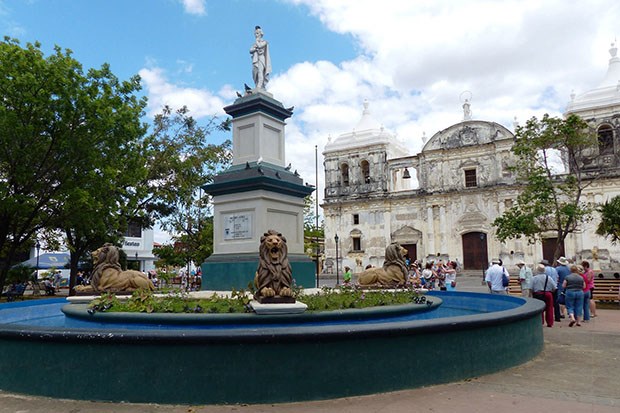Nicaragua’s old capital, León proves the most distinctive destination of many excursions during a recent Panama Canal cruise.
In the centre of this venerable city stands World Heritage León Cathedral. Blending a unique baroque flair and neo-classical grandeur, a haloed Virgin Mary stands gloriously atop. And just below, sculpted pairs of husky Atlanteans support the heavy beams between its central gable and bell towers.
Interestingly, these supermen refer subtly to the 17th century’s vision of Atlantis and its link to the New World. The façade’s 12 ornamental columns conjure the eras of Rome and Greece.
“The topmost statue represents Maximo Jerez, an early Nicaraguan president and liberal thinker,” explains guide Miguel.
Strolling onward, Miguel tells us how cathedral architecture was adapted to this area’s perilous terrain. Studying the low profile and thick walls, we can understand how it’s survived earthquakes, volcanic eruptions and warfare.
Inside, Christ’s 12 apostles adorn soaring columns. Miguel mentions that during cathedral construction, prominent citizens bought tombs below the marble floor. Nine wealthy notables, 10 bishops, five priests and three poets are entombed here. Ruben Dario’s tomb rests just below Saint Paul. There, a marble lion weeps for Nicaragua’s world-renowned poet, journalist and diplomat.
“Dario’s childhood home is now a city museum,” Miguel notes. “Nicely restored, it displays Dario’s personal belongings, first editions of his work and photographs showing his literary triumphs in Paris, Madrid, Buenos Aires and Chile.”
The cathedral also displays several masterpieces of Spanish colonial art, among them the statue of the black Christ still retaining scars of a pirate’s sword.
Our tour also offers a remarkable panoramic view of León. Entering through a cathedral’s side door, our group ascends a long, narrow spiral stairway upward to the rooftop. To explore the newly whitewashed expanse, we must remove our shoes... and wear sunglasses in order to avoid a blinding reflection. The gigantic snow-white statuary and 34 domes remain bedazzling.
Among the many bells, we examine La Libertad, which announced Central America’s independence to the world. “Great vista, eh?” Miguel proudly grins. “Perfect too for cannons. Artillery was placed here to defend Leon from conservative forces in 1824 and later against dictator Somoza’s soldiers during our 1979 revolt.”
Just below stands Central America’s second oldest university, which has been graduating thinkers for centuries. These scholars likely formed the liberal factions who continually challenged the status quo. In the distance, brood eight volcanoes.
Exiting the Cathedral, we stroll around the large plaza. At one corner a large mural shows the struggles of early settlers. Another depicts Sandinistas fighting Somoza’s army and the later Contras, counter-revolutionaries. Nearby, a sculpted sawdust portrait of Venezuela’s Hugo Chavez straddles the sidewalk.
In this once turbulent Third World country, the plaza looks very peaceful. There are no armed police, no beggars and no desperate vendors. Motorists are rare; instead, plainly dressed folk whisper past on old bicycles. Sitting on shaded benches beneath large trees, young couples hold hands.
Under colourful umbrellas near a bandstand, people sell local products. Looking over their collections of handicrafts, we buy carved wooden bowls as well as bags of dark roasted coffee and icy coca-colas.



